I started putting this together yesterday morning before North Korea spat its dummy over the border to the South. Here’s hoping the timing isn’t prescient.
A week off work and I have finally got around to properly scanning my mother’s copy of Leeds and the Bomb at a usable resolution. The versions here are 20% the original scan and haven’t been processed apart from being resized and saved as PNG in Paint.Net. Click the thumbnails for the resized versions. I have high-resolution copies available and can post them if anyone wants them. The images are readable (and are pretty faithful to the state of the original pamphlet after twenty one years). A bit of tweaking of contrast in your image editor of choice can tart them up quite nicely though.
The pages are below. Reading them, you might reasonably ask whether Leeds City Council which produced the pamphlet might have something to say about it being reproduced on-line. A quick look at page two will tell you that this brilliant little pamphlet was an early example of a publication released under a form of proto-creative commons.
Former Councillor Brian North said in a comment on the earlier post:
I devised and Edited Leeds and the Bomb . The booklet sold 60,000 copies worldwide and went into three print runs. Reproduced in Holland, Germany, Japan, USA.
We can add the internet to that list now.
The cover cleverly juxtaposes the apocalypse with lovely shades of pink and baby blue (in fairness, my copy is rather faded so the colours were probably more appropriate originally). Look closely and you’ll see that the pamphlet is well-thumbed. The markings left by a terrified youth.
Page two points out that the pamphlet wasn’t intended to espouse any view on the necessity or otherwise of nuclear weapons. This was written at the height of the disarmament argument (it wasn’t really a debate or didn’t seem like one to me at the time) though. One way or another, an objective assessment of the effects of a nuclear attack on Leeds was unlikely to create any love for the nukes.
Pages four and five are an introduction to nukes and their place in the world. Interesting that Israel was down as a ‘can make a bomb now’ state (they actually already had them at the time as we found out from Mordechai Vanunu in 1986) and North Korea is not on the radar. If only they’d stayed that way.
I love the final line on this page, “Europe of course, included Britain”.
Pages six and seven talk about how a war would start. We really had no idea what the ‘90s and early years of the new century would bring. It might also be worth re-appraising Admiral Le Rocque’s statement that World War III, like the other world wars, would be fought in Europe.
Pages eight and nine start to get in to the meat of it. The three pictures of a housing estate being steadily destroyed look remarkably like Little London, just down the road from Blenheim where I did most of my growing up. I fully expected to be one of the lucky folk for whom, “The initial flash of nuclear radiation could kill anyone out in the open…”. Lovely.
Page eleven has the first of the excellent diagrams the pamphlet used to clearly describe the effects of the bomb. This displays the blast-damage that could be expected from the one megaton nuke that is used to illustrate the effects of the bomb.
Pages twelve and thirteen have more of the diagrams – flash burns and fallout this time.
Pages fourteen and fifteen form the centrepiece diagram which draws everything else together into a single, coherent image of doom. I always loved that the major roads and motorways were clearly marked – you certainly wouldn’t want to get lost during the apocalypse.
As a diagram, I’ve always loved it though. I liked that a number of different but related ideas were presented in a single diagram without it becoming cluttered or unreadable. Looking at it today, I find it amazing that this was probably put together using a mix of hand drawing and Letraset.
Pages sixteen and seventeen make what’s come before seem comforting. One of the ideas that we had was that once the warning went out (and the air-raid sirens were tested with alarming frequency – including at Blenheim TA Barracks), it would be best to head on up to Woodhouse Moor to make sure we got fried in the first light of the bomb. That way we wouldn’t suffer the horrors likely to be inflicted on survivors. We came to this conclusion based on our in-depth study of Threads (Leeds got a pamphlet, Sheffield got a film – typical) and various other pieces of post-apocalyptic fiction that we got our hands on.
The pamphlet now presents a ‘realistic’ war scenario of bombings at Leeds-Bradford airport in Yeadon and the Royal Ordinance Factory in Barnbow. In this scenario, the centre of Leeds would very probably still be at least partially standing. In other words, we might survive to enjoy the depredations of societal breakdown, radiation sickness and starvation. The post-war North comes next.
When we moved to Headingly in about 1987, our new GP had a poster on the wall of his waiting room from the BMA. It was a photograph of a hideously melted telephone receiver. The text of the poster warned readers in stern terms against calling their doctor in the event of nuclear war. This was since, there would A) be no phone and B) your doctor would be dead or otherwise engaged. These reminders of the dangers we faced were all around us and put today’s terrorist threat into perspective. Whatever horrors bearded cave-dwellers might try to inflict on us, they simply don’t have the existential character of all-out nuclear war. Also, in the UK at least, concern about terrorism in the public ebbs and flows whereas the fear of nuclear war was pretty much constant. We knew war could start ‘accidentally’ at any time and we suspected that the people with their fingers on the various buttons weren’t necessarily all there mentally or morally.
I had a look around the web for a copy of the BMA poster and also for the famous poster of Maggie and Ronnie posed as Rhett and Scarlett under the tag-line, ‘The Film to End All Films’ and a mushroom cloud rising in the distance. I found a few images, none particularly usable. One was very interesting; in a brief photo-blog by the right-wing US commentator, Michelle Malkin. It turns out that there’s a copy of the poster hanging on the wall of the Reagan ranch. I suppose he took it in good humour then.
Pages 20 and 21 get onto the question of command and control. There would have been attempts to maintain some degree of government and coordination from a bunker in Lawnswood (just up the road from my high-school). As Threads made clear though, there was no real expectation that anything effective could have been achieved. In the last few years, we have learned much more about the scenario planning that was performed by the government to prepare for the post-apocalypse world.
This information was released after a Freedom of Information request in 2006 and showed that Central Government had in effect been writing its very own collection of post-apocalyptic fiction in which possible responses to the break-down of society were examined. The friend who pointed me to this said:
It’s a terrifying read, the Death of Bristol in particular making for
nightmare stuff:http://www.subbrit.org.uk/rsg/features/sfs/new_page_2.htm
[…]
“In Exercise Regard, Newark declared itself independent “under an able
but despotic leading citizen” and with the acquiescence of the local
police. In Exercise Regenerate a large part of east Scotland had
declared itself independent under a local Parliament and supported by
an army battalion. Should these people be stopped, if so how, or
should they be accepted and integrated into the system?”
The bottom line is that the picture of the severe looking bobby on page 21 is unlikely to have been the reality.
Page 23 has a reminder of quite how demented the logic of nuclear war was. In the section asking whether evacuation would be an option, the pamphlet says:
What about evacuation? Would people be safer moving out of the towns and cities to the country? The problem with this is that no-one knows which parts of the country would be completely safe from fall-out. There might not be time for an evacuation. Evacuation might be seen as a hostile act and could lead to a nuclear attack.
In other words, the Soviets might think we were planning a pre-emptive attack because we evacuated and as a result, pre-emptively attack us. The civil defence policy described in ‘Protect and Survive’ demonstrates central government opposition to evacuation:
No help will be given to people who move away from home. [Protect and Survive] also warns that empty homes might be taken for others to use.
This sounds like a particularly grim version of compulsory purchase, known as eminent domain in the US.
An interesting tid-bit from page 24 points out that:
The spread of nuclear weapons to the middle-east or Africa, might increase the chances of a nuclear war.
It missed Asia from the list but otherwise seems to have been correct. There is potential conflict between Iran and Israel, Pakistan and India and North and South Korea (for which the US offers a nuclear umbrella). This means that we live in a world where nuclear conflict is more likely than at any time in the last couple of decades. It is not certain that a local conflict would escalate into a global war. At any rate, it is less certain than it was in 1982, but the prospect is nonetheless a touch grim.
The final pages are a glossary of doom. They contain a reminder that Hard Rock isn’t just a nasty restaurant full of tat.
That’s the lot. It’s interesting to re-read it today in light of the new nuclear threats from smaller states and others. One way or another, the world is a whole lot safer than when we were growing up and yet somehow people feel much less safe. We put up with all sorts of idiotic rubbish at airports for the sake of avoiding (or at least appearing to avoid) threats that seem trivial compared to those we faced in the 1980s.
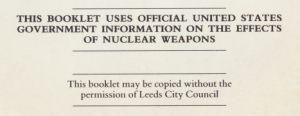
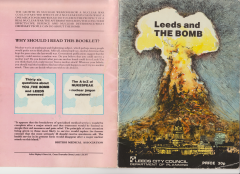

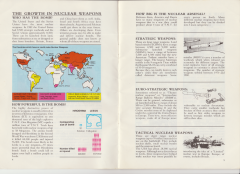


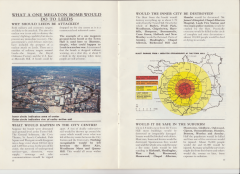
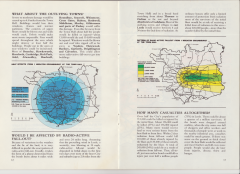
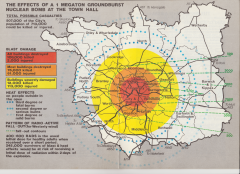

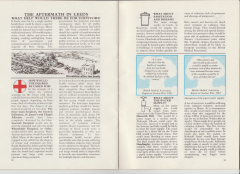
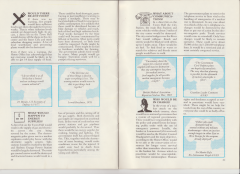
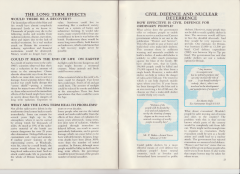
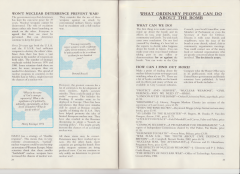
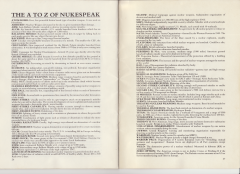
Hi Matt
Thanks for providing these full size scans, I was trying to download them all so I could print out a copy of the leaflet but pages 24-25 are not available in full size like the others. Please could you update the post so I can print out these vital last two pages that are missing.
Cheers!
Johnny
Hi Johnny,
Fixed it. Enjoy!
Pingback: 68. The Day After: Bradford and the Bomb | 100 Objects
Amazing stuff brilliant read ! 🙂